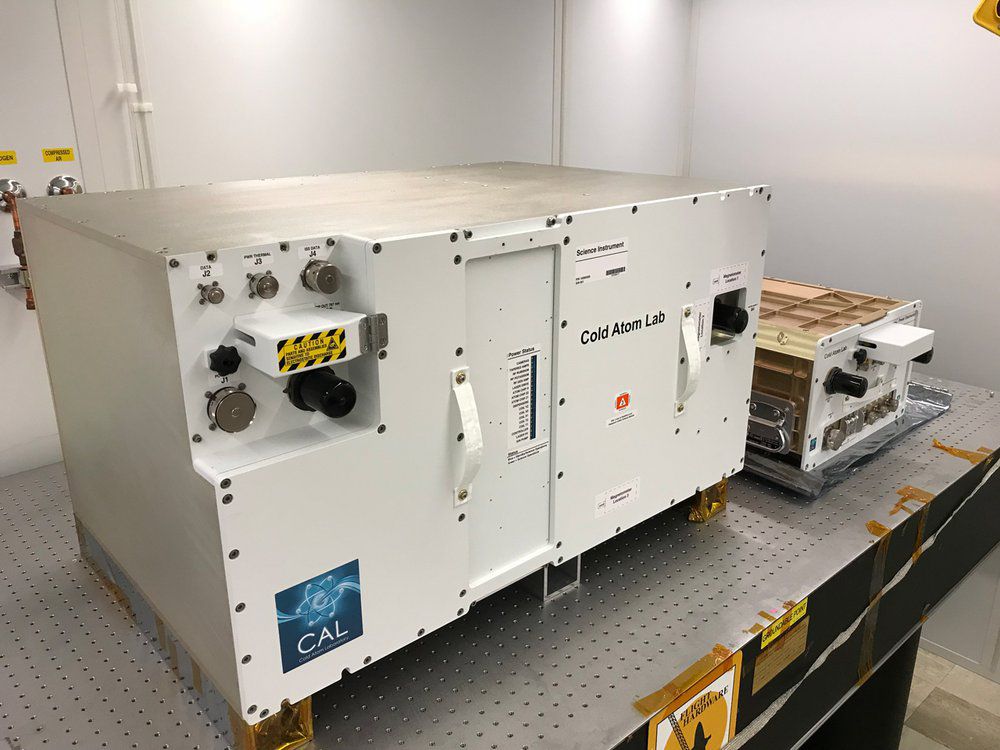One lab at NASA’s Jet Propulsion Laboratory in Southern California is literally trying to defy gravity. The Cold Atom Lab (CAL) at JPL allows scientists to investigate the properties of atoms and explore the space of quantum science.
CAL began operating on the International Space Station in the summer of 2018. The lab’s mission is to study ultra-cold quantum gases in microgravity.
CAL is the size of a mini-fridge and contains instruments used to perform quantum experiments.

We spoke to Dr. Ethan Elliott, an atomic physicist involved in the CAL project.
“The instrument is built to study fundamental laws of nature. The smallest particles in the universe follow a completely different set of rules. They can move through each other, they can be in two places at once and we call those rules quantum mechanics,” said Dr. Elliott.
In a nutshell, the atomic physicist says CAL is a portable lab that allows scientists to study quantum mechanics uniquely. Dr. Elliott likes to use a popular sci-fi analogy to explain it.
“The Avengers can shrink down and go down to the quantum realm. We can’t do that yet. But what we can do is make the quantum realm bigger,” said Dr. Elliott.
The CAL instrument works by using lasers and magnetic fields to chill atoms to below a billionth of a degree above absolute zero. That’s colder than the average temperature of the universe, which is 2.726 Kelvin.
CAL is the coldest place in space.
The lab is unique compared to other ultracold labs on Earth because CAL can chill atoms to colder temperatures and for longer periods of time.
It’s taking quantum science to a whole new level!
Dr. Elliott says the instrument exploits a law of quantum mechanics that applies to both the very small and very cold.
He told us “if we can get big things cold enough, then they take on the properties of quantum particles.”
Atoms chilled inside CAL move slower than a garden snail. This allows scientists to look at an atom’s behavior and discover how our world works on the smallest scales.
Plus, some atoms can reach a fifth state of matter called a Bose-Einstein condensate (BEC). In 2018, the Cold Atom Lab made history by being the first facility to produce BECs in Earth’s orbit.
The BECs are large enough that they could be visible to the naked eye, but you can’t actually see them this way because if you hit them with light, they break apart in a fraction of a second.
The team uses infrared cameras/lights to observe them and determine their density, motion and temperature.
In addition, the lab is also the first quantum science lab in the Earth’s orbit. Scientists build CAL at JPL and then send to the ISS to operate it remotely.
Five groups of scientists use CAL to perform a variety of experiments, from measuring gravity to producing ultracold atoms. An example of one experiment scientist do is shaping atoms into bubbles to see how they behave in different shapes and geometries.

We spoke to Irena Li, a mission operations engineer on the Cold Atom Lab. She coordinates with the ISS teams in Houston, Texas and Huntsville, Ala. to operate CAL remotely.
"I push buttons that make lasers fire onboard the International Space Station to make atoms go really, really cold,” said Li.

The mission operations engineer also says it rewarding work with the group of scientists on this mission.
“It really takes people from all over the world to get the science to run the way it does. There are a lot incredibly brilliant and incredibly tenacious across this program… none of them have never given up on this program and that’s why it works,” Li told us.
The future is limitless for the Cold Atom Lab. They upgraded the lab earlier this year with new atomic technology called an atom interferometer. JPL says the tool will allow scientist to make precise and subtle measurements with gravity.
Measuring gravity with a high degree of precision or subtlety has a lot of applications, from better spacecraft navigation, or studying a planet's or moon's composition.
The Cold Atom Lab is working on new hardware right now and they will install it next summer
Plus, they’ll also be studying the ultracold bubbles they produced earlier this year and see if they can transition them into the BEC state.
This research is important because it can allow scientists to find practical applications to these materials and understand the fundamental laws of the universe..
Our team of meteorologists dives deep into the science of weather and breaks down timely weather data and information. To view more weather and climate stories, check out our weather blogs section.
Keith Bryant - Senior Digital Weather Producer
Keith Bryant is a meteorologist and Senior Digital Weather Producer for Spectrum News. He graduated from San José State University and Mississippi State University with degrees in Broadcast Journalism and Operational Meteorology. He started his career as a news producer working in various markets. After 6 years of TV news, he’s excited to inform the public on the latest weather news for Spectrum.







